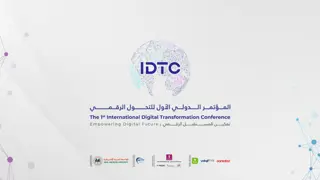
Global Growth of Digital Transformation in Banking and Finance
Explore the global growth of digital transformation in banking and finance, highlighting key trends, innovations, and the impact on financial services worldwide. Discover how technology is reshaping the industry to enhance customer experience, effici
Uploaded on | 1 Views
Download Presentation

Please find below an Image/Link to download the presentation.
The content on the website is provided AS IS for your information and personal use only. It may not be sold, licensed, or shared on other websites without obtaining consent from the author. If you encounter any issues during the download, it is possible that the publisher has removed the file from their server.
You are allowed to download the files provided on this website for personal or commercial use, subject to the condition that they are used lawfully. All files are the property of their respective owners.
The content on the website is provided AS IS for your information and personal use only. It may not be sold, licensed, or shared on other websites without obtaining consent from the author.
E N D
Presentation Transcript
Global Growth of Digital Transformation in Banking and Finance Table of Contents Introduction Key Factors Driving Digital Transformation in Finance The Technology Powering Digital Transformation Developing a Digital Transformation Strategy Conclusion Introduction The market for global digital transformation in banking and finance is expected to touch $310.7 billion by 2032. There are various reasons propelling this growth. While digitalization is not new to finance and banking, it has become more relevant. Traditional service providers need to keep pace with changing customer needs and evolving trends, from omnichannel marketing to automation. However, challenges remain for businesses looking to digitally transform their financial services. Some of the most common ones, especially for utilizing new software, include security concerns, compatibility with existing systems, catering to vulnerable customers (such as those who are differently abled or older), staff training, and in-house skills to manage the software. Leveraging the expertise of a digital transformation company can help meet such challenges.
Key Factors Driving Digital Transformation in Finance Streamlined internal operations: Automation and AI are improving internal processes, making operations more efficient and giving financial service providers a competitive edge. Data Analytics: Advanced data tools help service providers make better decisions by breaking down data silos, leading to improved risk management and innovation. Customer Journey: Companies are adopting a more customer-focused approach by using data and new technologies to personalize services for each individual. Security Measures: Digital transformation includes adopting stronger cybersecurity to protect customer data. New technologies enhance fraud detection and ensure compliance with regulations in the growing online banking space. The Technology Powering Digital Transformation Digital transformation in the finance industry can be successfully realized with the latest and most suitable technology. Below are some of the technologies that have been (and are being) used for digitalization in banking and finance, along with the pros and cons of each one. Blockchain and Distributed Ledger Technology (DLT) Blockchain s data-driven and transparent nature makes it a popular technology in banking and finance. It has led to more secure transactions of data and an improved interface that meets customer expectations. Banks are using blockchain for cross-border payments, trade finance, and digital identity verification. Distributed ledger technology simplifies recording and verifying transactions, reducing the need for intermediaries and improving the speed and accuracy of financial operations.
For instance, blockchain can reduce settlement times for securities trading, which traditionally takes days to complete. Smart contracts that is, self-executing contracts with predefined terms are also gaining traction in automating financial agreements. Advantages: Enhanced Security:Blockchain s decentralized nature and cryptographic techniques increase security and reduce the risk of data breaches. Transparency and Traceability: Every transaction is recorded on a public ledger, improving transparency and enabling easy tracking. Reduced Intermediaries: Minimizes the need for middlemen, thus lowering transaction costs and speeding up processes. Smart Contracts: Automate and enforce agreements without the need for intermediaries. Disadvantages: Scalability Issues: Processing speeds can be slower compared to traditional systems, especially with public blockchains. Energy Consumption: Some blockchain implementations, particularly those using Proof of Work, can be energy intensive. Regulatory Uncertainty: The evolving regulatory landscape may create compliance challenges. Application Programming Interface (API) An API is a software interface that allows different applications to share data and services without needing to build everything from scratch. This helps businesses create new products and services, connect more easily with new customers and partners, and improve operational efficiency.
Advantages: Enhanced Integration: Facilitates seamless interaction between different systems and applications, promoting innovation and efficiency. Faster Development: Enables quicker creation of new products and services by leveraging existing functionalities. Improved Customer Experience: Allows for personalized and streamlined interactions with customers. Disadvantages: Security Risks: Exposing APIs can create vulnerabilities if not properly secured. Dependency Issues: Reliance on third-party APIs can lead to potential disruptions if the services encounter issues. Cloud Computing Cloud computing has emerged as a foundational technology in the digital transformation of the financial sector. Cloud-based infrastructure allows banks to scale their services quickly, improve agility, and reduce IT costs. Via cloud migration, financial institutions can avoid large upfront investments in data centers and instead pay for services on a pay-as-you-go basis. Hybrid cloud solutions, which combine public and private cloud environments, are especially popular in the finance industry due to their ability to balance data security with operational flexibility. Cloud computing also accelerates innovation by providing banks with the infrastructure needed to develop and deploy new digital services, such as mobile banking apps and real-time payment platforms.
Advantages: Scalability: Offers flexible scaling of resources based on demand, helping financial institutions handle varying workloads. Cost Efficiency: Reduces the need for large capital investments in IT infrastructure with a pay-as-you-go model. Innovation Acceleration: Provides a robust platform for developing and deploying new digital services. Disadvantages: Data Security and Privacy: Storing sensitive financial data on cloud servers raises concerns about data protection and compliance with regulations. Downtime Risks: Dependence on cloud service providers introduces potential risks in terms of service outages. Vendor Lock-In: Switching providers can be complex and costly, leading to potential vendor lock-in. Robotic Process Automation (RPA) RPA helps service providers automate repetitive, rule-based tasks, such as data entry, compliance reporting, and customer service inquiries. This reduces human error, increases efficiency, and frees up employees to focus on higher-value tasks. For example, RPA can be used to process loan applications, perform account reconciliations, and generate financial reports, with minimal manual intervention. Advantages: Increased Efficiency: Automates repetitive tasks, speeding up processes and reducing human error.
Employee Focus: Frees up employees to focus on more strategic and value-added activities. Disadvantages: Limited Flexibility: RPA is best suited for rule-based tasks and may struggle with more complex or unstructured processes. Maintenance Costs: Bots require ongoing maintenance and updates to adapt to changing processes or systems. Initial Setup Costs: Implementing RPA can involve significant initial setup costs and time. Artificial Intelligence (AI) and Machine Learning (ML) AI and ML are transforming the banking and finance industry by automating tasks, analyzing vast amounts of data, and providing personalized services. AI-powered chatbots enhance customer service, while ML algorithms help detect fraud, assess credit risk, and offer tailored financial advice. In investment banking, AI-driven tools are revolutionizing trading by enabling algorithmic trading, which executes trades based on predefined criteria and market conditions. AI also plays a crucial role in risk management, as it can analyze market trends and customer data to identify potential risks and opportunities. Advantages: Advanced Analytics: Provides tools for analyzing large datasets, leading to better decision-making and risk management. Fraud Detection: Improves fraud detection and prevention with sophisticated algorithms that identify unusual patterns and behaviors. Disadvantages:
Data Privacy Concerns: AI systems often require extensive data collection, raising privacy and security concerns. Biases: If the training data contains biases, AI algorithms may inadvertently perpetuate them. Internet of Things (IoT) IoT refers to a network of physical devices, like smartwatches or thermostats, equipped with sensors and software to collect and share data. For banks, this technology enables customers to make instant contactless payments and manage their accounts via mobile banking. It has also improved risk management and enhanced the authorization process. Advantages: Enhanced Convenience: Facilitates seamless, contactless transactions and real-time account management via connected devices. Improved Risk Management: Provides real-time data that can enhance risk assessment and management. Customer Insights: Offers valuable data on customer behavior and preferences for more personalized services. Disadvantages: Security Vulnerabilities: Connected devices can be vulnerable to hacking and other security threats. Data Privacy: Collecting and managing large amounts of personal data raises privacy concerns. Integration Challenges: Integrating IoT devices with existing systems can be complex and require significant effort.
Developing a Digital Transformation Strategy To fully leverage digital transformation in finance, companies need to learn how to navigate certain key areas. Public Cloud With the rise of public cloud services, traditional data centers and their supporting staff, which once handled broad organizational needs, are becoming less essential. Now, a small team can manage and adjust cloud infrastructure based solely on the needs of their specific product. While this shift might not always result in significant cost savings depending on the efficiency and capacity of the data center it offers the advantage of moving from large upfront investments to a pay-as-you-go model, where costs are variable and based on actual usage. Even in the cautious financial services sector, public cloud infrastructure is quickly becoming the preferred option. According to Gartner, by 2028, the cloud will shift from a disruptor to a necessity to maintain a competitive advantage. However, while many financial service providers have deployed workloads to the cloud, much of their processing stays on outdated, monolithic mainframe applications. Nonetheless, though the cost of updating systems for cloud migration is substantial, the trend is accelerating.
Data and Processes Data and processes in a mainframe are closely connected, and these connections become more complex over time. Since many of these systems are over 30 years old, separating their intertwined applications into individual parts can be daunting. Any change to one process can impact others, requiring extensive testing to ensure nothing breaks. Data Accessibility Core business data, such as accounts, positions, and client demographics, is typically stored in large, centralized back-end systems. While data is easily accessible within these systems, any changes to one component require testing the entire system, usually limiting updates to once per quarter. This allows time for thorough testing and coordination across teams. Because these systems are often outdated, integrating their data with newer systems can be strategically difficult. Conclusions Digital transformation is reshaping the banking and finance industry, offering opportunities for enhanced customer experiences, increased innovation, and improved operational efficiency. While challenges such as legacy systems, cybersecurity risks, and regulatory compliance remain, banks that successfully embrace digital transformation will be better positioned to thrive in the digital age. As the financial industry continues to evolve, companies that make an effort to stay on top of the latest digital transformation developments will be better positioned as industry leaders. Silverskills is a digital transformation company with over 20 years of experience serving organizations around the world, from Fortune 500 giants to agile SMEs. Our cutting-edge digital
contributions have transformed client processes, enhancing efficiency, reducing costs, and improving customer satisfaction. Contact us now to leverage our solutions. Meta title Digital Transformation in Finance: Global Growth What s driving the global growth of digital transformation in finance and banking, and how can companies leverage Meta description it? Primary keyword Digital Transformation in Finance LSI keywords digital transformation in finance industry Service-specific keywords digital transformation company, financial services URL digital-transformation-in-finance Banks are using blockchain for cross-border payments, trade finance, and digital identity verification. By 2028, the cloud will shift from a disruptor to a necessity to maintain a Blog highlights competitive advantage.






















